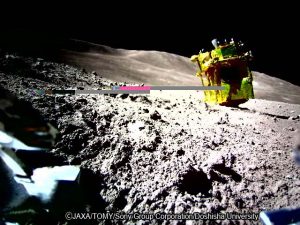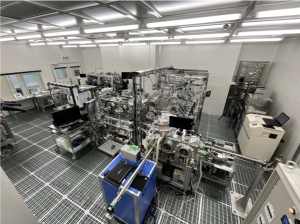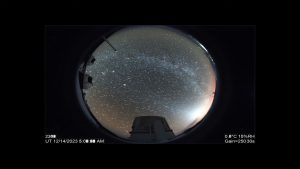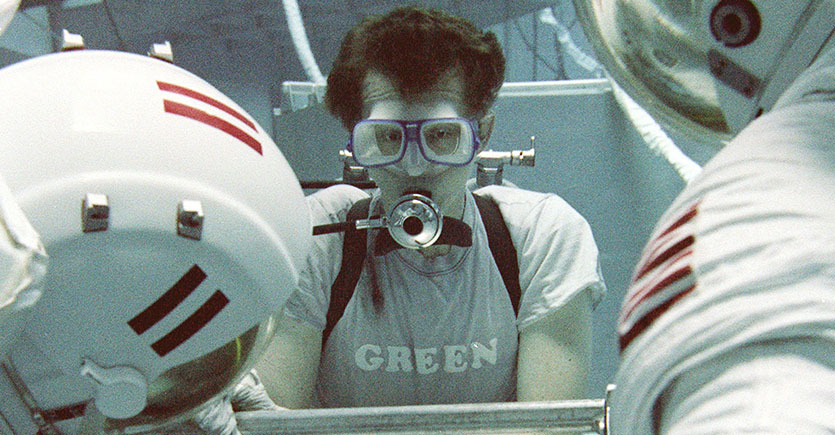
Global space news: NASA’s Juno photographs Ganymede

On June 7, the NASA Juno spacecraft captured two amazing close-ups of the surface of Jupiter’s moon, Ganymede. The largest moon in the Solar System, Ganymede is a fascinating world due to its rare ability to produce a magnetic field and because it may possess all the requirements for life. Japan is therefore joining with the European Space Agency (ESA) to explore Ganymede and the neighbouring icy moons in the upcoming mission, JUICE.
The surface image of Ganymede, obtained for the first time since it was observed by the Galileo spacecraft, made me excited to imagine JUICE visiting Ganymede in about 10 years. I believe that Juno’s Ganymede flyby will reveal a new picture of Ganymede and also new mysteries for JUICE to solve.
Yoshifumi Saito, Project Manager for JUICE-ISAS
The JUpiter ICy moons Explorer (JUICE) is an ESA-led mission to explore Ganymede and also make detailed observations of Jupiter’s other two icy moons, Europa and Callisto. The mission marks the second major collaboration between ESA and JAXA, following on from the BepiColombo Mercury mission that consists of two orbiters from the two space agencies.
An ESA large-class mission with a staggering eleven instruments, JUICE will be carrying the most powerful payload flown in the outer Solar System. Three of these instruments are being built by ISAS, with a fourth from NICT Japan, and our researchers will also assist in the development of two of the other instruments. This is not a mission that JAXA could take on alone, but reflects exactly how far you can go with international partnerships.
Ganymede is the largest moon in the Solar System and is an “icy moon” with surface covered with ice. However, it has been suggested that there may be a liquid sea beneath that layer of ice. We are developing the Ganymede Laser Altimeter (GALA) for the JUICE mission led by the European Space Agency (ESA) through international collaboration. GALA will measure the tidal response of Ganymede from orbit around the moon to investigate the underground sea and internal structure that cannot be seen from the outside. We consider that investigating the internal structure of icy moons will be an important step toward astrobiology and extraterrestrial life search.
Keigo Enya, Project Manager for JUICE/GALA-Japan
Jupiter has three large moons that are covered with ice but are thought to harbour a liquid ocean below the frozen shell. On slightly elliptical paths around Jupiter, the moons’ distance from the giant gas planet changes over an orbit. This creates variations in the gravitational pull from Jupiter, flexing the moons and creating heat. The resultant “tidal heating” is thought to prevent the underground oceans on the moons from freezing solid.
Liquid water is a key ingredient needed for life. Another is a source of energy for life, such a hydrogen, methane and organic molecules. On the icy moons, organics forming or delivered to the surface would have to pass through the frozen lid to reach the ocean below. Whether this is possible, or if life could begin in a world without land, are questions that JUICE will tackle.
Does life exist or not in ocean worlds? Tackling this question may lead to the answer as to how the Earth became a planet full of life. What kind of environment is within the beautiful icy world photographed by Juno? Is there energy there to support life? I am looking forward to discovering these answers with the exploration of JUICE.
Shino Suzuki, Department of Interdisciplinary Space Science
Ganymede will be the primary scientific focus for JUICE. Unlike the other Jovian moons, and even Mars and Venus, Ganymede produces its own magnetic field. This makes it only the third known world with a solid surface to do so, after the Earth and Mercury. Investigating how Ganymede’s magnetic field interacts with the far stronger field of Jupiter is a key interest for the ISAS team, who have been studying how the surface of a planet or moon can be protected by a magnetic field in different environments. BepiColombo is another piece in that puzzle, as Mercury’s short orbit feels the full force of high energy particles in the solar wind, mimicking conditions on exoplanets that orbit close to their star such as Proxima Centauri b.

JUICE will also study Ganymede’s icy neighbours, Europa and Callisto to compare their environments. Callisto sits further from Jupiter than Ganymede, and is not thought to benefit from tidal heating, making it a different geological environment from its icy siblings. Its heavily crater-marked face suggests an old surface that could provide clues to the moons’ initial formation, although this may also mean that organics could not have reached Callisto’s interior. If Callisto does indeed host an internal ocean, it is perhaps the least likely to host life. This is not true for the inner Europa, whose surface shows cracks that could allow material to be exchanged with the hidden ocean. These cracks will be studied by JUICE as possible evidence of plate system similar to the one that assists life on Earth. Europa is also the target for its own mission from NASA. The Europa Clipper will conduct a detailed survey of the moon from orbit to map the surface and use radar to assess the internal structure.
JUICE is scheduled to launch in 2022, with an arrival in the Jupiter system 7.6 years later and a plan to spend 3.5 years studying the moons.
“Global space news” is a chance for us to highlight important developments across the world and share our excitement of these achievements.
Further information:
JUICE-JAPAN website
BepiColombo Mio orbiter website


 Previous Post
Previous Post Next Post
Next Post






